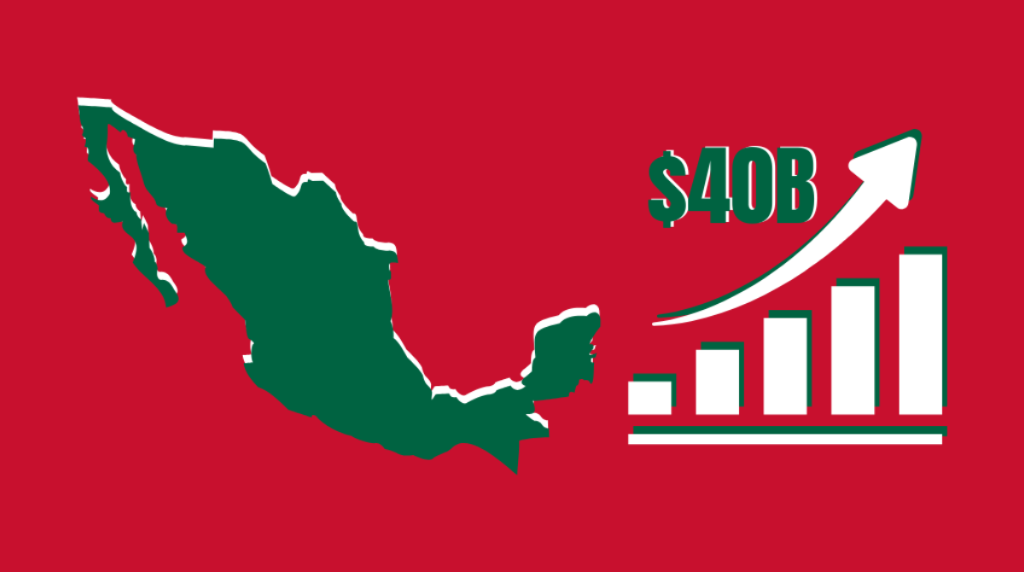Report: Mexico Will See Gambling Market Worth $40 Billion by 2033
Valued at $11.37 billion in 2024, the Mexican gambling market is forecast to skyrocket to $40.64 billion by 2033, driven by a powerful annual growth rate of 15.71%. This estimate comes from a new prospectus from Astute Analytica.

Mexico’s gambling market predicted to eclipse $40 billion by 2033.
Key Facts:
- By 2033, the Mexico gambling market may be worth as much as $40 billion in US Dollars, says an Astute Analytica prediction
- Prognostication includes casino, online casino, lottery, iGaming, and sports betting sectors
- AI will drive innovation and betting platform features for growing consumer base in the country
Once considered a fragmented patchwork of informal venues and loosely enforced rules, Mexico’s gambling scene is rapidly evolving into a high-stakes arena of innovation, oversight, and digital-first disruption.
Mexico’s gambling sector is evolving rapidly, marked by surging mobile engagement, tightening regulations, and uneven growth between online and land-based venues. While casinos fight inflation and falling foot traffic, digital operators are racing ahead on the back of mobile innovation and youth-driven demand.
This explosive growth is playing out across a dual landscape: sleek online platforms designed for mobile-first engagement, and land-based casinos that increasingly align with Mexico’s broader tourism ambitions.
While the digital wave sweeps through smartphones and tablets, brick-and-mortar establishments reinvent themselves with hybrid experiences blending entertainment, hospitality, and tech.
At the heart of this transformation lies a tightening regulatory framework. Revisions to the Federal Gaming and Raffles Law (LJRS) in recent years have added teeth to what was once seen as a lenient system.
Operators are now held to higher financial standards, including mandatory capital reserves of $2 million and enforced geofencing to restrict unauthorized foreign access.
However, Mexico’s decentralized governance presents a complex compliance puzzle. Jalisco, for example, levies a 7% tax on gross gaming revenues, while tourism-friendly Quintana Roo offers tax breaks to integrated resorts. These jurisdictional contrasts often leave operators juggling local nuances on top of federal mandates.
Further scrutiny came after the Financial Action Task Force (FATF) flagged deficiencies in anti-money laundering controls during a 2023 audit. In response, real-time monitoring of bets exceeding $2,500 has become mandatory, funneled through SEGOB’s central reporting infrastructure—a move applauded by watchdogs and fintech advocates alike.
Yet not all is rosy. Shadow operations in regions like the State of Mexico and Guerrero continue to siphon funds from legal operators—an estimated $450 million annually, according to SEGOB.
The presence of unlicensed gambling dens, coupled with sluggish licensing timelines (which can stretch 12 to 18 months), has discouraged market entry for newcomers. Penalties for regulatory breaches, particularly those involving AML violations, can soar as high as $1.5 million, fortifying the dominance of entrenched players like Grupo Caliente and Codere.
On the horizon, a game-changing policy decision looms. Federal authorities are set to issue a ruling by late 2024 on whether cryptocurrencies can be formally integrated into the gambling ecosystem.
With blockchain-backed operators like Betcris already gaining ground, this decision could reshape how bets are placed and validated—ushering in a new digital chapter for the Mexican gambling economy.
Mexico’s nearly 250 land-based casinos faced another tough year in 2023, as annual revenue dipped 5% to $1.4 billion.
The downturn is most visible in urban hubs like Mexico City and Monterrey, where casinos reported an 8% decline in per-venue earnings. Rising labor costs (up 12%) and a generational shift toward online betting have eroded traditional casino margins.
Despite the gloom, some high-end operations are thriving. Grupo Caliente’s Tijuana Hippodromo Casino posted a 14% jump in VIP table game revenue, largely fueled by affluent gamblers from nearby San Diego.
However, smaller operators continue to shut down—14 casinos in Baja California have closed since 2022.
Online Betting Booms with Mobile Power and Youthful Energy
While physical casinos struggle, Mexico’s digital gambling scene is thriving. Online platforms are expected to match land-based revenues at $1.4 billion in 2024, thanks to 82% smartphone penetration and affordable data plans.
Players aged 18 to 34 now represent 71% of digital bettors. They’re drawn to platforms offering real-time experiences like Bet365’s Liga MX streams and Codere’s generous bonuses. Live dealer games grew 33% year-over-year, and Evolution Gaming now hosts half a million monthly baccarat players via Mexico-focused tables.
Cash remains king for many players—OXXO’s Spin voucher service processes 41% of deposits—though Bitcoin usage is creeping upward at 6%. Regulatory uncertainty still clouds the crypto space, but new payment channels are making gambling more accessible.
Sports Betting Drives Engagement and Raises Integrity Questions
Sports betting remains the heartbeat of Mexico’s gambling market, accounting for nearly 40% of total revenues. Soccer reigns supreme—Liga MX alone generated $2.1 billion in bets during the 2023 Apertura, surging 18% during high-profile matches like América vs. Chivas.
Still, the dark side of sports betting persists. SEGOB’s Integrity Unit uncovered match-fixing schemes involving third-division players, and AI-based monitoring tools now flag irregular activity in 92% of Liga MX games.
Other sports like basketball and baseball are growing, too—NBA games in Mexico City spurred a 27% jump in prop bets, and FanDuel’s partnership with the Sultanes de Monterrey added $12 million in new baseball handle.
Economic Impact of Mexico’s Gambling Industry
The gambling industry supports 148,000 direct jobs, but low pay remains an issue—dealers average just $460 per month, 23% below the living wage. The federal government collected $700 million in gambling taxes last year, with casinos contributing the lion’s share through a 30% tax on gross revenue.
Tourism, Casinos, and Cross-Border Play Fuel Growth
Integrated resorts are blending gambling with broader tourism offerings. Grupo Vidanta’s Nuevo Vallarta destination draws half a million annual visitors, 44% from the US, thanks to creative gaming, luxury, and entertainment bundling.
Cruise ships are also a big driver—Royal Caribbean’s Cozumel stops generate $180 million from casino-linked excursions. Meanwhile, US bettors are increasingly crossing digital borders: nearly one in four Texas players uses a VPN to access Mexican sportsbooks.
Tech Investment Accelerates, But Gaps Remain
Mexican operators poured $230 million into tech upgrades last year, with AI and blockchain at the forefront. Codere’s chatbot now handles 83% of customer queries with high satisfaction scores, and Caliente is using machine learning to flag signs of problem gambling.
Virtual reality casinos are slowly gaining traction—Win Systems’ VR parlors in Guadalajara are pulling in 12,000 users monthly, though steep hardware costs remain a barrier.
Still, not all regions are keeping pace. Just 38% of casinos in Oaxaca have 5G access, though partnerships with Telcel aim to bring 150 new 5G-enabled betting zones online by 2025—potentially a game changer for esports and real-time betting experiences.

 Google Blocks Horse Racing Affiliate Ads in the US
Google Blocks Horse Racing Affiliate Ads in the US
 Play’n GO Releases Buildin’ More Bucks on December 11, 2025
Play’n GO Releases Buildin’ More Bucks on December 11, 2025
 US Online Gambling Poised for Major 2025 Growth
US Online Gambling Poised for Major 2025 Growth